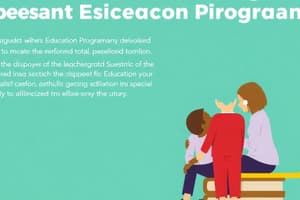Podcast
Questions and Answers
What does the acronym IDEA stand for?
What does the acronym IDEA stand for?
- Inclusion Development Education Act
- Individualized Disability Education Act
- Individuals with Disabilities Equal Act
- Individuals with Disabilities Education Act (correct)
The Education for All Handicapped Children Act of 1975 is now known as?
The Education for All Handicapped Children Act of 1975 is now known as?
- Individuals with Disabilities Education Act (IDEA) (correct)
- Children with Disabilities Act
- All Children Education Act
- Education for Disabled Children Act
What type of education are all children from ages 3 through 21 entitled to under IDEA?
What type of education are all children from ages 3 through 21 entitled to under IDEA?
Free, Appropriate Public Education (FAPE)
General education teachers today have more students with disabilities in their classrooms than ever.
General education teachers today have more students with disabilities in their classrooms than ever.
What does Least Restrictive Environment (LRE) refer to?
What does Least Restrictive Environment (LRE) refer to?
What is Mainstreaming?
What is Mainstreaming?
What is Inclusion in the context of education?
What is Inclusion in the context of education?
What is Full Inclusion?
What is Full Inclusion?
Under IDEA, students with disabilities must fit into at least one of thirteen categorized disability groups to qualify for IDEA services.
Under IDEA, students with disabilities must fit into at least one of thirteen categorized disability groups to qualify for IDEA services.
What defines At-Risk Students?
What defines At-Risk Students?
What is Section 504 of the Rehabilitation Act of 1973?
What is Section 504 of the Rehabilitation Act of 1973?
Section 504 only applies to schools.
Section 504 only applies to schools.
The law provides funding for Section 504.
The law provides funding for Section 504.
What is the Americans with Disabilities Act (ADA) of 1990?
What is the Americans with Disabilities Act (ADA) of 1990?
What does the IDEA principle 'Zero Reject' mean?
What does the IDEA principle 'Zero Reject' mean?
What is required under the IDEA principle of Nondiscriminatory Evaluation?
What is required under the IDEA principle of Nondiscriminatory Evaluation?
What is meant by Free and Appropriate Education under IDEA?
What is meant by Free and Appropriate Education under IDEA?
What does the Least Restrictive Environment principle entail?
What does the Least Restrictive Environment principle entail?
What does the Due Process principle under IDEA refer to?
What does the Due Process principle under IDEA refer to?
What is Parent Participation under IDEA?
What is Parent Participation under IDEA?
What are Transition Services according to IDEA?
What are Transition Services according to IDEA?
What does the Early Childhood Education principle under IDEA entail?
What does the Early Childhood Education principle under IDEA entail?
What is the requirement under IDEA for Assessments?
What is the requirement under IDEA for Assessments?
What is the principle of Early Intervention Services according to IDEA?
What is the principle of Early Intervention Services according to IDEA?
Under the No Child Left Behind Act (NCLB), schools that fail to make adequate yearly progress must offer parents the option to transfer their children to another public school.
Under the No Child Left Behind Act (NCLB), schools that fail to make adequate yearly progress must offer parents the option to transfer their children to another public school.
Every Student Succeeds Act (ESSA) replaced NCLB and allows states to choose their own academic standards.
Every Student Succeeds Act (ESSA) replaced NCLB and allows states to choose their own academic standards.
What are the Common Core State Standards (CCSS)?
What are the Common Core State Standards (CCSS)?
What does the Continuum of Services refer to in education?
What does the Continuum of Services refer to in education?
What is the Self-Contained Model in special education?
What is the Self-Contained Model in special education?
What is the Resource-Room Model (Pull-Out Model)?
What is the Resource-Room Model (Pull-Out Model)?
Flashcards are hidden until you start studying
Study Notes
IDEA Overview
- IDEA stands for Individuals with Disabilities Education Act, providing educational rights to children with disabilities.
- Initially established as the Education for All Handicapped Children Act of 1975, it now ensures a Free, Appropriate Public Education (FAPE) for ages 3-21.
Inclusion in Education
- General education classrooms increasingly include students with disabilities since the implementation of IDEA.
- Least Restrictive Environment (LRE) mandates that students with disabilities learn alongside their peers whenever possible, forming the basis for inclusive education.
- Mainstreaming involves placing special needs students in regular classrooms with the necessary support.
Types of Inclusion
- Inclusion refers to educating students with disabilities in general classrooms under the general education teacher's supervision.
- Full Inclusion promotes the integration of all students, including those with severe disabilities, into every aspect of school life.
Eligibility and Services
- Students qualify for IDEA services by fitting into at least one of the thirteen disability categories, such as Autism, Deafness, or Learning Disabilities.
- At-risk students are those likely to fail academically or lack future success due to their environments or experiences.
Section 504 and ADA
- Section 504 of the Rehabilitation Act of 1973 protects individuals with disabilities from discrimination in federally funded institutions and mandates FAPE.
- The Americans with Disabilities Act (ADA) of 1990 requires reasonable accommodations for employees and public facility accessibility.
IDEA Principles
- Zero Reject ensures all students with disabilities have access to public education.
- Nondiscriminatory Evaluation requires fair assessments that consider the student's needs.
- Free and Appropriate Education (FAPE) mandates individualized education programs (IEPs) tailored to each student's unique learning requirements.
Parental and Student Rights
- Due Process guarantees confidentiality and parental involvement in planning educational services.
- Parent Participation emphasizes collaboration between schools and families in special education processes.
- Transition Services, effective by age 16, aid students in moving from school to post-school opportunities.
Early Education and Support
- Early Childhood Education entitles young children under three to an individualized family service plan (IFSP) focusing on family needs.
- Early Intervention Services allocate funding for support to students not identified for special education but in need of assistance.
Assessment and Accountability
- Students with disabilities must participate in state and district-wide assessments, with alternative assessments available if justified.
- Under the No Child Left Behind Act (NCLB), schools failing to meet adequate yearly progress must offer student transfer options at the district's expense.
- The Every Student Succeeds Act (ESSA) replaced NCLB, allowing states to establish their academic standards and accountability systems.
Educational Models
- Common Core State Standards (CCSS) outline the necessary knowledge and skills for students' college and career readiness.
- Continuum of Services provides a range of instructional settings from full-time general education placements to specialized facilities.
- Self-Contained Model means students primarily receive instruction from special education teachers.
- Resource-Room Model involves students receiving special education services outside the general classroom setting.
Studying That Suits You
Use AI to generate personalized quizzes and flashcards to suit your learning preferences.



